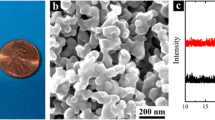Abstract
We show that low-density nanoporous silica monoliths (aerogels), in contrast to the case of full-density silica, exhibit pronounced time-dependent deformation during indentation at room temperature. Logarithmic indentation creep and stress relaxation are revealed, with an exponential dependency of the creep constant on the applied stress. Such time-dependent deformation is attributed to stress corrosion fracture of nanoligaments that have a large surface-to-bulk atomic fraction.



Similar content being viewed by others
References
R.W. Pekala, C.T. Alviso, and J.D. LeMay: Organic aerogels: Microstructural dependence of mechanical-properties in compression. J. Non-Cryst. Solids 125, 67 (1990).
J. Gross, J. Fricke, R. Pekala, and L.W. Hrubesh: Elastic nonlinearity of aerogels. Phys. Rev. B 45, 12774 (1992).
T. Woignier, J. Reynes, A.H. Alaoui, I. Beurroies, and J. Phalippou: Different kinds of structure in aerogels: Relationships with the mechanical properties. J. Non-Cryst. Solids 241, 45 (1998).
M. Moner-Girona, A. Roig, E. Molins, E. Martinez, and J. Esteve: Micromechanical properties of silica aerogels. Appl. Phys. Lett. 75, 653 (1999).
E.M. Lucas, M.S. Doescher, D.M. Ebenstein, K.J. Wahl, and D.R. Rolison: Silica aerogels with enhanced durability, 30-nm mean pore-size, and improved immersibility in liquids. J. Non-Cryst. Solids 350, 244 (2004).
S.O. Kucheyev, T.F. Baumann, C.A. Cox, Y.M. Wang, J.H. Satcher Jr., and A.V. Hamza: Nanoengineering mechanically robust aerogels via control of foam morphology. Appl. Phys. Lett. 89, 041911 (2006).
H. Fan, C. Hartshorn, T. Buchheit, D. Tallant, R. Assink, R. Simpson, D.J. Kissel, D.J. Lacks, S. Torquato, and C.J. Brinker: Modulus-density scaling behavior and framework architecture of nanoporous self-assembled silicas. Nat. Mater. 6, 418 (2007).
A. Leonard, S. Blacher, M. Crine, and W. Jomaa: Evolution of mechanical properties and final textural properties of resorcinol-formaldehyde xerogels during ambient air drying. J. Non-Cryst. Solids 354, 831 (2008).
M.A. Worsley, S.O. Kucheyev, J.H. Satcher Jr., A.V. Hamza, and T.F. Baumann: Mechanically robust and electrically conductive carbon nanotube foams. Appl. Phys. Lett. 94, 073115 (2009).
S.O. Kucheyev, A.V. Hamza, J.H. Satcher Jr., and M.A. Worsley: Depth-sensing indentation of low-density brittle nanoporous solids. Acta Mater. 57, 3472 (2009).
C.A. Angell: Perspective on the glass-transition. J. Phys. Chem. Solids 49, 863 (1988).
S.O. Kucheyev, M. Toth, T.F. Baumann, A.V. Hamza, J. Ilavsky, W.R. Knowles, C.K. Saw, B.L. Thiel, V. Tileli, T. van Buuren, Y.M. Wang, and T.M. Willey: Structure of low-density nanoporous dielectrics revealed by low-vacuum electron microscopy and small-angle x-ray scattering. Langmuir 23, 353 (2007).
W.C. Oliver and G.M. Pharr: An improved technique for determining hardness and elastic-modulus using load and displacement sensing indentation experiments. J. Mater. Res. 7, 1564 (1992).
B. Abramoff and L.C. Klein: Elastic properties of silica xerogels. J. Am. Ceram. Soc. 73, 3466 (1990).
D.R. Daughton, J. MacDonald, and N. Mulders: Acoustic properties of silica aerogels between 400 mK and 400 K. J. Non-Cryst. Solids 319, 297 (2003).
S. Basu, M. Radovic, and M.W. Barsoum: Room temperature constant-stress creep of a brittle solid studied by spherical nanoindentation. J. Appl. Phys. 104, 063522 (2008).
E. Orowan: The fatigue of glass under stress. Nature 154, 341 (1944).
B.R. Lawn: Fracture of Brittle Solids (Cambridge University Press, Cambridge, MA, 1998).
T.A. Michalske and S.W. Freiman: A molecular interpretation of stress-corrosion in silica. Nature 295, 511 (1982).
T.A. Michalske and B.C. Bunker: Slow fracture model based on strained silicate structures. J. Appl. Phys. 56, 2686 (1984).
S.O. Kucheyev, M.A. Worsley, J.H. Satcher Jr., A.V. Hamza, and T.F. Baumann (2009).
ACKNOWLEDGMENTS
The authors thank J.H. Satcher, Jr. for providing the nanoporous silica monolith used in this study. This work was performed under the auspices of the U.S. Department of Energy (DOE) by LLNL under Contract DE-AC52-07NA27344.
Author information
Authors and Affiliations
Corresponding author
Rights and permissions
About this article
Cite this article
Kucheyev, S., Lord, K. & Hamza, A. Room-temperature creep of nanoporous silica. Journal of Materials Research 26, 781–784 (2011). https://doi.org/10.1557/jmr.2010.68
Received:
Accepted:
Published:
Issue Date:
DOI: https://doi.org/10.1557/jmr.2010.68




